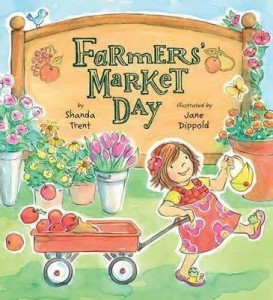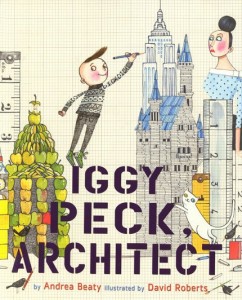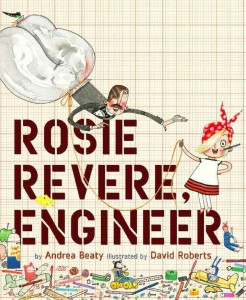Rosie Revere, Engineer
I have the best of reasons for posting late this week: I’ve been on Mackinac Island at the Michigan Reading Association conference, being inspired by dedicated educators and loving the slower pace of an island with no automobiles. Now I’m sitting in a white wicker rocking chair with a cup of coffee and my laptop, dear husband at my side, watching sailboats glide by. The only thing that could make this any better would be a great book, and luckily, I have one.
Rosie Revere, Engineer written by the marvelously talented Andrea Beaty and illustrated by David Roberts is one of the rare rhyming book gems: the story is as solid as the meter and the language isn’t dumbed down in order to make a rhyme. Rosie Revere is the kind of girl most creative people will relate to: joyfully inventive, but so fearful of failure and ridicule that she hides her inventions away. The “gadgets and gizmos” she creates are fantastic, and I love Roberts’ whimsical and yet credible drawings of them. (I myself would love a pair of Rosie’s helium pants.) Rosie’s desire to help her great-great-aunt Rose fulfill her lifelong dream of flying gives Rosie the courage to test one of her inventions.
“The heli-o-cheese-copter sputtered and twitched.
It floated a moment and whirled round and round,
then froze for a heartbeat and crashed to the ground.”
Rosie is devastated by the failure, and by her great-great-aunt’s laughter, until she hears,
“‘Your brilliant first flop was a raging success!
Come on, let’s get busy and on to the next!’“
So not only is the message of this book one that every creative person with perfectionist tendencies needs to hear (I’m keeping it by my bedside table as a reminder) but it has historical notes in it about Amelia Earhart and E. Lillian Todd (the first woman to design airplanes) and Rosie the Riveter and other strong women whose names and deeds should be known. For a social studies lesson, you could easily springboard from this book into studying awesome women inventors. For math-science-art, get graph paper and a bunch of doodads and thing-a-ma-bobs for students to plan, design, build, test, and refine their own inventions. If you ask people to donate old, broken electronic gadgets to your class and bring in small tools, your students can take apart old radios and remote controls to disassemble and use. Build those Phonological Awareness skills by focusing on the rhyme, then discuss the interesting word choices for a Craft & Structure lesson. To keep rocking those Core Standards in Reading, you can easily work in Integrating Knowledge & Ideas by comparing Rosie Revere, Engineer to Iggy Peck, Architect by the same power duo.
So share this book with absolutely everyone you know, and get busy taking creative risks, because
“Life might have its failures, but this was not it.
The only true failure can come if you quit.”
For more information on the author, please visit andreabeaty.com.
For more information on the illustrator, please visit davidrobertsillustration.com.
Farmers’ Market Day
 I am counting the days until my local farmers’ market opens. Until then, I’m glad I found this perfect pick: Farmers’ Market Day written by debut picture-book author Shanda Trent and illustrated by Jane Dippold. This rhyming book is a quick read that can easily be turned into an interactive “imagination” station or a fun math center for students to practice counting money.
I am counting the days until my local farmers’ market opens. Until then, I’m glad I found this perfect pick: Farmers’ Market Day written by debut picture-book author Shanda Trent and illustrated by Jane Dippold. This rhyming book is a quick read that can easily be turned into an interactive “imagination” station or a fun math center for students to practice counting money.
A little girl and her family go to the farmers’ market on Saturday. The little girl has her own money from her piggy bank and she’s not sure what to buy – maybe a basket of cherries, a jar of honey, freshly-baked bread or flowers for the garden? Each enticing item is labeled with a price tag, like $2.00, or 12/$3.00, or 50 cents. Reading aloud this short rhyming book will have your little listeners eager to choose what they’d buy for themselves, and that’s where you can extend the book in ways to draw your students back to rereading.
Younger students can make their own farmers’ market in a pretend-play area. Plastic fruits, vegetables, and flowers can be bought and sold. Students can use Farmers’ Market Day to decide what should be for sale and how much to write on each price tag. (Using the information found in both the text and the pictures is a way of Integrating Knowledge and Ideas. Woohoo!) Older students can use the book to practice money skills. Ears of corn cost $3.00 per dozen – how many ears of corn do you need to feed your class, and how much will it cost? If you have $10.00, what items would you buy? Show your shopping list! With summer and real live farmers’ markets just around the corner, Farmers’ Market Day is a real treat.
Read MoreIggy Peck, Architect
 Long have I loved Andrea Beaty’s picture book series about a bear named Ted (grab Doctor Ted, Firefighter Ted, and Artist Ted from your local library and prepare to be charmed.) Then, I saw sitting on the shelf by the Ted books this gem, just waiting to tie in perfectly with science, math, and phonological awareness lessons.
Long have I loved Andrea Beaty’s picture book series about a bear named Ted (grab Doctor Ted, Firefighter Ted, and Artist Ted from your local library and prepare to be charmed.) Then, I saw sitting on the shelf by the Ted books this gem, just waiting to tie in perfectly with science, math, and phonological awareness lessons.
Iggy Peck, Architect written by Andrea Beaty and illustrated by David Roberts will grab young readers on page 1:
“Young Iggy Peck is an architect
and has been since he was two,
when he built a great tower – in only an hour –
with nothing but diapers and glue.”
The story about a young boy who loves to build and saves the day with his architectural skills is told in fantastic rhyme. (Hello, Common Core Standard of Phonological Awareness!) But the beauty of this book is that after you’ve used it in reading lesson, it inspires all kinds of science, art, and math extensions.
When his class is stranded on a small island, Iggy teaches his classmates how to construct a suspension bridge from “boots, tree roots and strings, fruit roll-ups and things”. After sharing Iggy Peck, Architect, pull out Bridges by Seymour Simon to learn more about suspension bridges and how they work (and pat yourself on the back for Integrating Knowledge and Ideas, you Core Standard wizard.) You may choose to forgo tree roots and boots, but challenge your students to plan and construct a suspension bridge, perhaps between two tables, with materials like string, paper, straws, etc. Students can use graph paper like David Roberts did when they draw up their plans, measuring actual distances and then scaling the distances down on paper before they build. Your students will be measuring, counting, drawing, predicting, and revising as they work. Keep architecture books like Bridges! Amazing Structures to Design, Build, and Test by Carol A. Johmann and Elizabeth J. Rieth, or the wonderful David Macaulay books on hand for those inspired by Iggy Peck. As Miss Lila Greer, the teacher in Iggy Peck, Architect realizes:
“There are worse things to do when you’re in grade two
than to spend your time building a dream.”
For more information about the author, go to andreabeaty.com.
For more information about the illustrator, go to davidrobertsillustration.com.
Read MoreMy favorite Earth Day book: Wangari’s Trees of Peace
 Sometimes I fear that I can’t make a real difference in helping the planet, but Wangari’s Trees of Peace: a true story from Africa by Jeanette Winter shows how powerful one person’s actions can be. Wangari Maathai was devastated to see how barren Kenya was after thousands of trees were cleared. Soil was eroding and crops wouldn’t grow. The birds were gone. Women walked for miles to gather firewood. “I can begin to replace some of the lost trees here in my own backyard – one tree at a time.”
Sometimes I fear that I can’t make a real difference in helping the planet, but Wangari’s Trees of Peace: a true story from Africa by Jeanette Winter shows how powerful one person’s actions can be. Wangari Maathai was devastated to see how barren Kenya was after thousands of trees were cleared. Soil was eroding and crops wouldn’t grow. The birds were gone. Women walked for miles to gather firewood. “I can begin to replace some of the lost trees here in my own backyard – one tree at a time.”
Wangari started with nine seedlings, which grew into a nursery. Wangari gave new seedlings to village women for them to plant, and gave them money to keep those trees thriving. When Wangari tried to stop the clearing of old trees, she was beaten and arrested. But her message of caring for the Earth was taking root just like her trees were, and because of her, Kenyan women planted over 30 million trees, saving their land and making life there better.
For Earth Day/Arbor Day/natural resources units/biography units/non-fiction read-alouds that you can finish in one sitting, this is my new go-to book. Just by reading it and discussing it with students, you’re hitting the Common Core Standard of Range of Reading (a biography that teaches science and social studies? Non-fiction score!) Wangari’s Trees of Peace is also excellent for an ecological cause-and-effect lesson, one of the big pieces of Key Ideas and Details. Using the book for reference, students can write and draw the effects of deforestation (crops wouldn’t grow, birds were gone, lack of firewood) and the effects of planting all those trees (women don’t have to walk so far to gather firewood, more birds, crops growing in the soil.) Winter’s picture book doesn’t delve deeply into the science of why a lack of trees leads to soil erosion, so you can share Planting the Trees of Kenya: the story of Wangari Maathai by Claire A. Nivola if you need to build that knowledge with your students. Use both books as resources for student writing and drawing, and now you’re Integrating Knowledge and Ideas!
If in the past you’ve received more apple-themed coffee mugs than you need as end-of-the-year teacher gifts, you can suggest that in lieu of a present for you, students can give a gift to us all by planting a tree. If you can spring for a seedling or if your parent-teacher organization will chip in, plant a tree with your students and let them help take responsibility for watering it (seeds are cool, but watering a visible seedling is way more exciting than watering a patch of dirt.) Wangari’s Trees of Peace may plant in your students a dedication to care for our planet.
Read More








